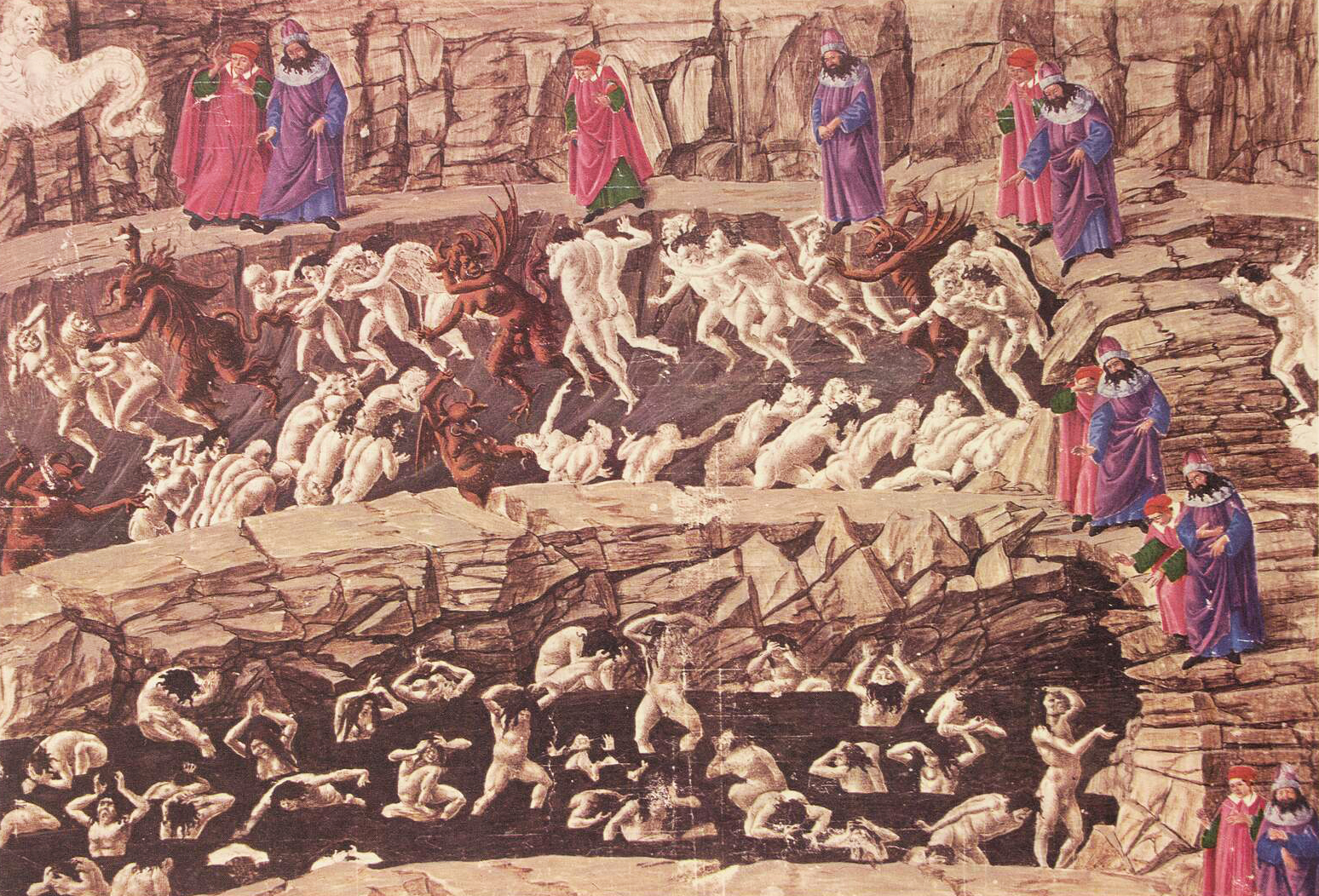Sandro Botticelli

Thought to have been commissioned by Lorenzo Pierfrancesco de Medici, Botticelli’s illustrations to the Divine Comedy are highly unusual and strikingly original, coming as they do from a leading painter of the Renaissance who was not known for working in this medium. Undertaking all aspects of book design, from arrangement of the text (with Niccolò Mangona as his scribe) through to illustration, seems to have been a unique venture for an artist during this period. Botticelli’s endeavour was not hugely successful at the time, but is now recognized as being both immensely inventive and among the artist’s best work, sophisticatedly balancing frenetic energy with moments of poise and elegance.
This was not the first version of the Comedy that Botticelli worked on; though the earlier version is now lost - we only know of it via references in Vasari (who was mildly scathing about the project as a whole) – it was thought to have influenced Baccio Baldini’s engravings. Botticelli’s interest in Dante nevertheless demonstrates a resurgence in the poet’s popularity during the 15th century.
Only nineteen of the illustrations are fully engraved and coloured; the majority are comprised of silverpoint drawings – a technique that uses a metal rod as a stylus on a surface prepared with a priming medium. The faint lines left behind were then worked over with ink.
Botticelli’s great innovation in these illustrations comes from his composition. Each canto is presented as a single illustration in a vertical format, with the various events of each set out simultaneously, so that Dante and his guide may appear multiple times within a given scene. This harkens back to a much earlier tradition of synchronous representation, present in some medieval art, but commonly used by narrative artists in classical antiquity. By the 15th century this device had been largely abandoned in printed books. On the facing page, the text is set out in four columns; each illustration is constructed to be read in the same way as the text, left to right and top to bottom, so that Dante’s position in the image matches the physical location of the corresponding description.
The University of Melbourne’s copy of Botticelli’s illustrations is a facsimile edition; the original has a fascinating history: at some point it was split into multiple parts, and most were lost for several hundred years, only to resurface in the 19th century, after interest in Botticelli’s work grew, having waned in the intervening period. The majority currently resides in the Museum of Prints and Drawings in Berlin, with some pages being held by the Vatican Library.
-

Sandro Botticelli, Inferno - Spaccato, plate 1, La divina commedia Dante Alighieri; illustrata da Sandro Botticelli, 1481, reprinted 1965, Rome: Canesi. Rare Books, Archives and Special Collections -

Sandro Botticelli, Paradiso XXIV, plate 85, La divina commedia Dante Alighieri; illustrata da Sandro Botticelli, 1481, reprinted 1965, Rome: Canesi. Rare Books, Archives and Special Collections -

Sandro Botticelli, Purgatorio XXX, plate 60, La divina commedia Dante Alighieri; illustrata da Sandro Botticelli, 1481, reprinted 1965, Rome: Canesi. Rare Books, Archives and Special Collections -

Sandro Botticelli, Inferno VIII, plate 3, La divina commedia Dante Alighieri; illustrata da Sandro Botticelli, 1481, reprinted 1965, Rome: Canesi. Rare Books, Archives and Special Collections -

Sandro Botticelli, Purgatorio III, plate 32, La divina commedia Dante Alighieri; illustrata da Sandro Botticelli, 1481, reprinted 1965, Rome: Canesi. Rare Books, Archives and Special Collections -

Sandro Botticelli, Purgatorio X, plate 39 (detail), La divina commedia Dante Alighieri; illustrata da Sandro Botticelli, 1481, reprinted 1965, Rome: Canesi. Rare Books, Archives and Special Collections -

Sandro Botticelli, Inferno XV, plate 8, La divina commedia Dante Alighieri; illustrata da Sandro Botticelli, 1481, reprinted 1965, Rome: Canesi. Rare Books, Archives and Special Collections -

Sandro Botticelli, Paradiso IV, plate 65, La divina commedia Dante Alighieri; illustrata da Sandro Botticelli, 1481, reprinted 1965, Rome: Canesi. Rare Books, Archives and Special Collections